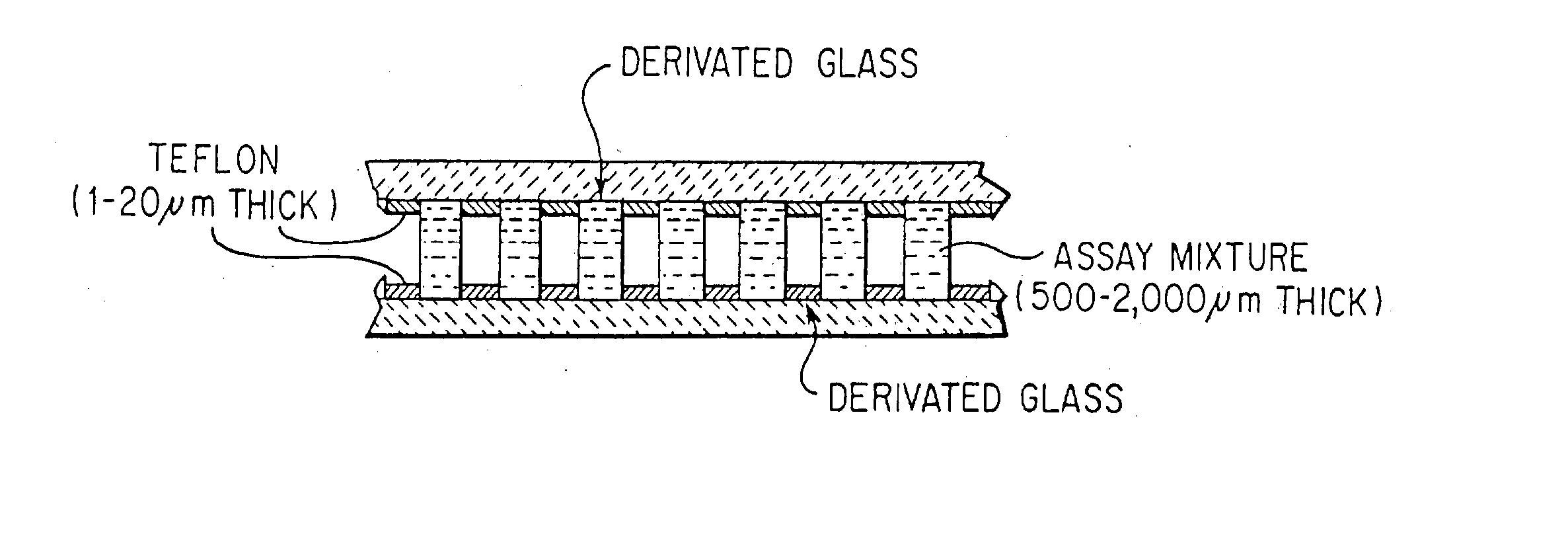Virtual wells for use in high throughput screening assays
- Summary
- Abstract
- Description
- Claims
- Application Information
AI Technical Summary
Benefits of technology
Problems solved by technology
Method used
Image
Examples
example 2
Transfer of Fluid Multiple Times From Virtual Wells
[0241] 5 .mu.l of .sup.33P-labeled H.sub.2O containing Malachite Green (to make it easier to see the H.sub.2O) was added to virtual wells on a glass slide. The slides used were commercially available TEFLON.RTM. coated glass slides (Cell Line). The TEFLON.RTM. was patterned so as to leave areas of glass exposed having a diameter of 2 mm. Fluid was transferred from the wells of this slide five successive times to five other slides by moving the other slides into close proximity to the first slide. The first transfer was done without a spacer; the next four transfers were done with a 40 mil spacer. The slides were dried, wrapped in plastic wrap, and measured on an Instantlmager from Packard. The transfer variance on any given slide was between 4% and 10% and the variance across all five slides was 10%.
[0242] The above-described experiment was repeated with DMSO rather than H.sub.2O as the solvent and with the virtual wells in the top ...
example 3
Cooling Slides to the Dew Point Limits Evaporation
[0243] The evaporation of a drop of water (approximately 20 nl to 30 nl) as a function of room temperature, room humidity, and the surface temperature of the slide on which the drop is placed was studied. 30 drops were dispensed simultaneously by piezo pipetting tip onto the surface of a glass slide and the time until the last drop evaporated was monitored. The results are shown in Table 3.
3 TABLE 3 % RH bench temp plate temp time to evap. 38 72 22 55 37 72 17.1 99 37 72 17.6 88 37 72 17.7 72 37 72 14.2 141 37 72 13.7 154 36 72 13.6 155 36 72 12.5 187 36 72 10.6 281 36 72 9.9 344 36 72 9.8 342 36 72 8 820 36 73 8 991 36 74 8.1 1179 36 74 7.3 2100 36 74 8.1 >3600 36 74 8.1 222 35 75 8.1 353 35 75 8.1 481
[0244] It can be seen from Table 3 that cooling the surface of the slide resulted in substantially increasing the time until the last drop evaporated. Of course, the surface of the slide cannot be cooled indefinitely; at some point con...
example 4
[0247] DMSO, labeled with a known concentration of .sup.33P-ATP, and present in a spatial array in virtual wells, was spotted onto glass slides using devices having pins that were made of gold coated tungsten wire. The diameter of the pins was varied in order to determine the effect of varying the diameter on the amount of fluid transferred. The device was manipulated by hand. The results are shown in Table 5.
5TABLE 5 SAMPLE ERROR (%) COUNTS 1 0.83 58,166 2 0.89 50,375 3 1.17 29,036 4 1.62 15,254 5 1.96 10,452 6 2.16 8,551 7 5.26 1,446 8 8.28 583 9 4.46 2,015 10 4.56 1,923 11 4.15 2,325 12 5.72 1,224 13 5.82 1,179 14 5.26 1,445 15 7.14 784 16 4.95 1,632 17 6.49 949 18 6.25 1,024 19 5.30 1,426 20 6.08 1,081 21 6.39 980 22 7.02 811 23 6.38 983 24 6.23 1,030 25 5.66 1,247 26 5.77 1,203 27 89.44 5 28 53.45 14 29 57.74 12 30 60.30 11 31 60.30 11 32 16.90 140 33 14.21 198 34 16.61 145 35 18.49 117 36 17.54 130 37 17.34 133 38 20.74 93 39 19.80 102 40 17.28 134 41 22.22 81 42 15.76 161 43 ...
PUM
 Login to View More
Login to View More Abstract
Description
Claims
Application Information
 Login to View More
Login to View More - R&D
- Intellectual Property
- Life Sciences
- Materials
- Tech Scout
- Unparalleled Data Quality
- Higher Quality Content
- 60% Fewer Hallucinations
Browse by: Latest US Patents, China's latest patents, Technical Efficacy Thesaurus, Application Domain, Technology Topic, Popular Technical Reports.
© 2025 PatSnap. All rights reserved.Legal|Privacy policy|Modern Slavery Act Transparency Statement|Sitemap|About US| Contact US: help@patsnap.com



